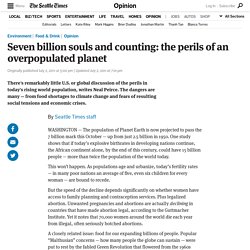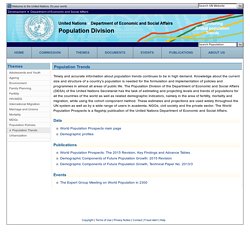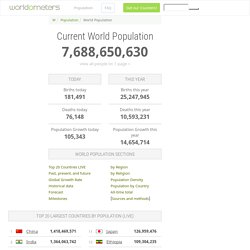

What's It All About, Shakespeare?: What is Macbeth Saying in the 'Tomorrow, and Tomorrow, and Tomorrow' Speech? Seven billion souls and counting: the perils of an overpopulated planet. There's remarkably little U.S. or global discussion of the perils in today's rising world population, writes Neal Peirce.

The dangers are many — from food shortages to climate change and fears of resulting social tensions and economic crises. WASHINGTON — The population of Planet Earth is now projected to pass the 7 billion mark this October — up from just 2.5 billion in 1950. One study shows that if today’s explosive birthrates in developing nations continue, the African continent alone, by the end of this century, could have 15 billion people — more than twice the population of the world today.
This won’t happen. As populations age and urbanize, today’s fertility rates — in many poor nations an average of five, even six children for every woman — are bound to recede. But the speed of the decline depends significantly on whether women have access to family planning and contraception services. A closely related issue: food for our expanding billions of people.
Why is this occurring? Key Findings WPP 2015. Trends - United Nations Population Division. Timely and accurate information about population trends continues to be in high demand.

Knowledge about the current size and structure of a country’s population is needed for the formulation and implementation of policies and programmes in almost all areas of public life. The Population Division of the Department of Economic and Social Affairs (DESA) of the United Nations Secretariat has the task of estimating and projecting levels and trends of populations for all the countries of the world as well as related demographic indicators, namely in the area of fertility, mortality and migration, while using the cohort component method.
These estimates and projections are used widely throughout the UN system as well as by a wide range of users in academia, NGOs, civil society and the private sector. The World Population Prospects is a flagship publication of the United Nations Department of Economic and Social Affairs. Data Publications Events The Expert Group Meeting on World Population in 2300. World Population Clock: 7.3 Billion People (2015) World Population: Past, Present, and Future (move and expand the bar at the bottom of the chart to navigate through time) The chart above illustrates how world population has changed throughout history.

Tomorrow and tomorrow and tomorrow. She should have died hereafter; There would have been a time for such a word. — To-morrow, and to-morrow, and to-morrow, Creeps in this petty pace from day to day, To the last syllable of recorded time; And all our yesterdays have lighted fools The way to dusty death.

Out, out, brief candle! Life's but a walking shadow, a poor player That struts and frets his hour upon the stage And then is heard no more. A-level Geography Population Revision - Population models. It is possible you will be asked about the consequences of Population growth.

Firstly, it is important that you appreciate two contrasting viewpoints. The first is from Malthus, who was writing at the end of the 18th century. He believed that only bad could come from population growth. Population he said grows faster than food supply. This he said was because food supply can only grow arithmetically, for example, 1 then 2 then 3-4-5-6-7-8 but, population grows geometrically 2-4-8-16-32-64. Consequently, there is no way food supply can keep up with population growth. Population grows exponentially, for example, 1-2-4-8-16-32-64.
Food supply grows arithmetically, for example, 1-2-3-4-5-6. Therefore, population will inevitably exceed food supply. He then went on two say that there are two possible outcomes. Firstly, he said population could exceed food supply only to be positively "checked" (reduced) by famine, war, and disease.
So who is correct? Malthusian Theory of Population. Thomas Robert Malthus was the first economist to propose a systematic theory of population.

He articulated his views regarding population in his famous book, Essay on the Principle of Population (1798), for which he collected empirical data to support his thesis. Malthus had the second edition of his book published in 1803, in which he modified some of his views from the first edition, but essentially his original thesis did not change. In Essay on the Principle of Population,Malthus proposes the principle that human populations grow exponentially (i.e., doubling with each cycle) while food production grows at an arithmetic rate (i.e. by the repeated addition of a uniform increment in each uniform interval of time).